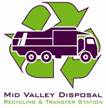AB341
 According to 2008 Statewide Waste Characterization data, the commercial sector generates nearly three fourths of the solid waste in California. Furthermore, much of the commercial sector waste disposed in landfills is readily recyclable. Increasing the recovery of recyclable materials will directly reduce greenhouse gas emissions (GHG) emissions. In particular, recycled materials can reduce the GHG emissions from multiple phases of product production; including extraction of raw materials, preprocessing and manufacturing. A co-benefit of increased recycling is avoided methane emissions at landfills from the decomposition of organic materials. Use of composted organic materials also provides environmental benefits such as carbon storage in soils and reduced use of fertilizers, pesticides, and water.
According to 2008 Statewide Waste Characterization data, the commercial sector generates nearly three fourths of the solid waste in California. Furthermore, much of the commercial sector waste disposed in landfills is readily recyclable. Increasing the recovery of recyclable materials will directly reduce greenhouse gas emissions (GHG) emissions. In particular, recycled materials can reduce the GHG emissions from multiple phases of product production; including extraction of raw materials, preprocessing and manufacturing. A co-benefit of increased recycling is avoided methane emissions at landfills from the decomposition of organic materials. Use of composted organic materials also provides environmental benefits such as carbon storage in soils and reduced use of fertilizers, pesticides, and water.
Mandatory Commercial Recycling was one of the measures adopted in the Assembly Bill 32 Scoping Plan by the Air Resources Board (ARB) pursuant to the California Global Warming Solutions Act (Chapter 488, Statutes of 2006). The Mandatory Commercial Recycling Measure focuses on increased commercial waste diversion as a method to reduce GHG emissions. It is designed to achieve a reduction in GHG emissions of 5 million metric tons of carbon dioxide (CO2) equivalents. To achieve the measure’s objective, an additional 2 to 3 million tons of materials annually will need to be recycled from the commercial sector by the year 2020 and beyond.
The Regulation was adopted at CalRecycle’s January 17, 2012 Monthly Public Meeting. This regulation reflects the statutory provisions of AB 341 (Chapter 476, Statutes of 2011 [Chesbro, AB 341]) and provides additional procedural clarifications. The regulation is currently pending approval by the Office of Administrative Law.
More information can be found at MidValleyDisposal.com.
Click on the links below to download a printable fact sheet:

